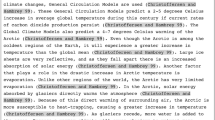Abstract
Literature instructors are using hypertext to enhance their teaching in a broad variety of ways that includes putting course materials on the WWW; creating online tutorials; using annotated hypertexts in addition to or in lieu of print texts; having students write hypertexts; examining the medium of hypertext as a literary and cultural theme; and studying hypertext fiction in the context of traditional literature classes. The article describes examples of each of these uses of hypertext in teaching literature and provides sources of further examples of and information on using hypertext as a teaching tool in literature classes.
Similar content being viewed by others
References
“The American Revolution and the struggle for Independence” (15 Dec. 1995): 3 pp. Online. Internet. 5 Jan. 1995. Available WWW: http://www.let.rug.nl/≈welling/usa/revolution.html
Barnes, William G. W. “Constructing Knowledge from an Ill-Structured Domain: Testing a Multimedia Hamlet.” American Education Research Association. New Orleans, 7 Apr. 1994. ERIC. ED372743.
Boaz, John K. “An Interart Study: Music and Modem Art in T. S. Eliot's The Waste Land.” Advertising Brochure (1995).
Boaz, John K. and Mildred M. Boaz. “T. S. Eliot on a CD-ROM: A Narrative of the Production of a CD.” Computers and the Humanities, 30: 3 (1996), 131–138.
Coleman, Mark. “Hypertext and the Humanities Classroom.” Technology and Higher Education, 113: 3 Spring 1993, 392–398; 352.
Davis, Charles T. “The Biblical Scholar's Path” (n.d.): n. pag. Online. Internet. 5 Jan. 1995. Available WWW: http://www.acs. appstate.edu/-davisct/
Davis, Charles T. “Computerizing Biblical Literature.” Computers and the Humanities, 30: 3 (1996), 117–119.
Dillingham, Thomas F. “Hypertext course.” CHORRT-L (27 Oct. 1994): n. pag. Online. Internet. 27 Oct. 1994.
Havholm, Peter and Larry Stewart. “Computer Modeling and Critical Theory.” Computers and Teaching Literature. Computer Research Section, M/MLA Convention. Marriott Pavilion Hotel, St. Louis, 3 Nov. 1995.
Havholm, Peter and Larry Stewart. “Computer Modeling and Critical Theory.” Computers and the Humanities, 30: 3 (1996), 107–115.
Homey, Mark. “Uses of Hypertext.” Journal of Computing in Higher Education, 2: 2 (Spring 1991), 44–65.
Huntley, John. “Teaching Milton by Computer.” Journal of Computing in Higher Education, 3: 1 (Fall 1991), 62–84.
Kemp, Fred. “Classroom use of Storyspace.” CHORRT-L (10 Oct. 1995): n. pag. Online. Internet, 10 Oct. 1995.
Kendall, Robert. “Hypertext class.” E-mail to author, 4 May 95.
Kendall, Robert. “Your hypertext class.” E-mail to author, 3 Jan. 96.
Landon, Brooks. “Brooks Landon's Horizon of Invisibility Homestead” (18 Dec. 1995): 15 pp. Online. Internet, 4 Jan. 1996. Available WWW http://www.uiowa.edu/-english/landon.html
Landon, Brooks. “Literature and Culture of Twentieth Century America” (27 Nov. 1995): 5 pp. Online. Internet. 4 Jan. 1996. Available WWW: http://www.uiowa.edu/≈english/litcult.html Landon, Brooks. “Web pages in lieu of final papers.” HUMANIST 9.394 (18 Dec. 1995): n. pag. Online. Internet, 20 Dec. 1995.
Landow, George P. “Hypertext in Literary Education, Criticism, and Scholarship.” Computers and the Humanities, 23 (1989), 173–198.
Lynch, Jack. “Literature Course Syllabi” (n.d.): 9 pp. Online. Internet, 5 Jan. 1995. Available WWW: http://www.english.upenn.edu/≈jlynch/syllabi.html
Moulthrop, Stuart and Nancy Kaplan. “Something to Imagine: Literature, Composition, and Interactive Fiction.” Computers and Composition, 9: 1 (November 1991), 7–23.
Saga, Hiroo. “Evaluation of the ‘Bunkyo Museum of Literature': A Hypercord-Based Interactive Video.” Association for Educational Communications and Technologies. Orlando, FL, 13–17 Feb. 1991. ERIC. ED357735.
Schwartz, Helen. “Using Hypertexts in Teaching Shakespeare for Presentation and Involvement.” Hypertexts for Teaching Imaginative Literature. MLA Convention. Hyatt Regency Hotel, Chicago, 29 Dec. 1995.
Shumate, Michael. “Hyperizons: the Hypertext Fiction Homepage” (1 Jan. 1996): 11 pp. Online. Internet. 5 Jan. 1996. Available WWW: http://www.duke.edu/≈mshumate/hyperfic.html
Slatin, John. “Poetic Conversations Home Page” (7 June 1995): 6 pp. Online. Internet, 5 Jan. 1995. Available WWW: http://www.cwrl.utexas.edu/≈ slatin/20c_poetry/
Slatin, John. “Web pages as final project.” H-CLC (21 Dec. 1995): n. pag. Online. Internet, 21 Dec. 1995.
Smith, Jonathan. “What's All This Hype about Hypertext? Teaching Literature with George P. Landow's The Dickens Web.” Computers and the Humanities, 30: 3 (1996), 121–129.
Spoehr, Kathryn T. and Amy Shapiro. “Learning from Hypermedia: Making Sense of a Multiply-Linked Database.” American Education Research Association. Chicago, 3–7 Apr. 1991. ERIC. ED333864.
Stevens, C. Robert. “316-K Stevens.” (n.d.): 16 pp. Online. Internet. 5 Jan. 1995. Available WWW: http://www.en.uen.utexas/≈roberts/e316_fa1195/index.html
Stevens, C. Robert. “Masterworks of World Literature.” World Lecture Hall: English (22 Nov. 1995): 8–9. Online. Internet, 5 Jan. 1995. Available WWW: http://wwwhost.cc.utexas.edu/world/instraction/index.html
Webpresentations. “CWRL home page” (28 Aug. 1995): 6 pp. Online. Internet, 5 Jan. 1995. Available WWW: http://www. cwrl.utexas.edu/
Wilhelm, Jeffrey. “Creating the Missing Links: Student-Designed Learning on Hypermedia.” English Journal, 84: 6 (October 1995), 34–40.
Author information
Authors and Affiliations
Additional information
Seth R. Katz is Assistant Professor of English at Bradley University in Peoria, IL. His research interests include computer applications in teaching literature and writing, and the grammatical analysis of poetic language. His recent publications include “Graduate Programs and Job Training” in Profession 95.
I presented a version of this article as part of a session on “Hypertexts for Teaching Imaginative Literature” at the MLA Convention in Chicago, December 29, 1995.
Rights and permissions
About this article
Cite this article
Katz, S.R. Current uses of hypertext in teaching literature. Comput Hum 30, 139–148 (1996). https://doi.org/10.1007/BF00419790
Issue Date:
DOI: https://doi.org/10.1007/BF00419790




